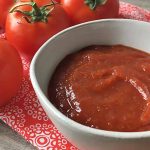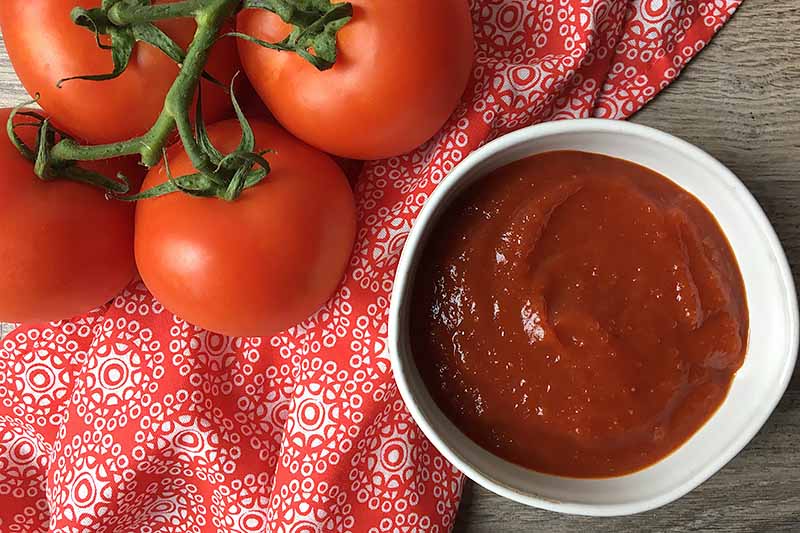Until very recently, it had never occurred to me that ketchup could be made in any way other than, well, grabbing a bottle at the grocery store.

But after deciding to eat a more natural diet, minimizing processed foods and ingredients, I wanted to give myself a small home kitchen challenge:
My goal as to try to make my own homemade version of this tangy condiment.
And I found that making your own is simple, natural, and even fun!

It’s so easy. All you need to do is put your ingredients in a stockpot or saucepan, cook them until they’re very soft, puree the mixture in a blender, strain, and cook it some more until most of the liquid is reduced.
What’s left behind is a concentrated, thick, spreadable sauce of pure tomato deliciousness.

Behold, catsup! Or ketchup, as most of us seem to commonly refer to it these days.
The liquid needs to be reduced significantly to get the right thick texture. To give you a sense of the reduction involved, two pounds of fresh Roma tomatoes resulted in just shy of one cup of the finished product.
So, if you want to make a bigger batch, this recipe can easily be doubled or tripled. It’s perfect for preserving a huge homegrown harvest if you’re going your own tomatoes at home. (If you’re interested, you can find some excellent tips for doing this on our sister site, Gardener’s Path).

Get ready to dip, drizzle, and spread your fries, hamburgers, hot dogs, and so much more with this sweet and tangy homemade delight – make the recipe below now.
Print
The Best Homemade Ketchup
- Total Time: 1 hour 25 minutes
- Yield: 1 cup 1x
Description
Put down the ketchup bottle, and make your own condiment right at home using fresh tomatoes. It’s simple, natural, and fun.
Ingredients
- 2 pounds tomatoes, roughly chopped
- 1 onion, roughly chopped
- 2 cloves garlic, roughly chopped
- 1/2 cup white vinegar
- 1/3 cup brown sugar, lightly packed
- 1 bay leaf
- 1/4 teaspoon celery seeds
- 1/4 teaspoon freshly ground black pepper
- 1 1/2 teaspoons kosher salt
Instructions
- Place all of the ingredients in a 5-quart stockpot or saucepan, and stir to combine. Cook over medium-high heat for about 15 minutes, until the onion is very soft and the tomatoes have released their juices.
- Remove the bay leaf, and set aside. Puree sauce in a high-speed blender or with an immersion blender until smooth. Strain sauce through a fine mesh strainer and pour the liquid back into the saucepan, along with the reserved bay leaf. Discard anything left over in the strainer.
- Place over medium-low heat. Cook, stirring occasionally, until the liquid has reduced significantly and the puree becomes very thick, yet still spreadable. This will take about 45 minutes to 1 hour, depending on the thickness you prefer. Adjust the other seasonings, if needed.
- Remove from the heat and cool to room temperature. Transfer to an airtight container and refrigerate until completely chilled. Store in the refrigerator for up to 2 weeks.
- Prep Time: 10 minutes
- Cook Time: 75 minutes
- Category: Spread
- Method: Stovetop
- Cuisine: Condiment
Keywords: tomato, ketchup, condiment
Cooking by the Numbers…
Step 1 – Gather and Prep

With a large cutting board and sharp knife, roughly chop the tomatoes, onion, and garlic cloves. Measure out the white vinegar, brown sugar, celery seeds, salt, and pepper. Set out one bay leaf.
Set out a large stockpot or saucepan, a fine mesh strainer, and a sturdy wooden spoon.
Leftover tomatoes? Learn how to store them properly, or learn how to dehydrate them in the oven.
Step 2 – Soften Ingredients

Place all ingredients in the saucepan. Cook over medium-high heat, stirring occasionally, until the vegetables are very soft and the tomatoes have released juices. This will take about 15 minutes.
Step 3 – Puree

Remove the bay leaf, and set aside. Transfer the sauce to a blender and puree until very smooth. You can also use an immersion blender for this step. Careful, the mixture will be hot!
Step 4 – Strain

Strain the pureed sauce through the strainer to separate the skin, seeds, and pulp from the vegetables. Firmly press down with a spoon to extract all the liquid. Add the strained liquid back into the saucepan, discarding anything left over in the strainer.

Step 5 – Reduce

Add the reserved bay leaf, and cook the liquid over medium-low heat, stirring occasionally, until most of the liquid is reduced and a thick sauce forms. This will take about 45 minutes to 1 hour, depending on the thickness you prefer.
Be sure to use a sturdy spoon in order to scrape the bottom and sides of the pan well, to prevent sticking and burning.
Step 6 – Cool and Serve

Remove from heat and cool to room temperature. Adjust seasonings, if needed. Transfer to an airtight container and refrigerate until completely chilled. Serve as you wish!
The ketchup will keep in the refrigerator for up to 2 weeks.
Homemade over Heinz!
The extent of my ketchup consumption has ranged from Heinz, to generic brands, to whatever was offered in those plastic red bottles at the dining hall in college.

However, as a girl who’s been eating mass-produced ketchup since she was old enough to hold a French fry, I can tell you this: the homemade version is so much more natural, more fun, and much tastier!
It’s different, and you’ll notice that. But it’s good, and you’ll notice that, too.
And when summertime comes, bringing with it baskets of harvested tomatoes at your local farmers market, you’ll know exactly what to do with them.
Try mixing up the flavors, if you want an even more exciting taste sensation. Add spices like cinnamon and cloves, or add a few squirts of Sriracha sauce for a spicier take. And you can use this as a base from homemade barbecue sauce, as well, for all of your summertime grilling.
Craving more condiments? Try our other spreads like homemade mayo, mustard, barbecue sauce, and all of our hummus recipes.
What do you think of our homemade version of this very popular topping? How do you like to use ketchup? Comment below, and be sure to rate our recipe.
Don’t forget to Pin It!

Photos by Nikki Cervone, © Ask the Experts, LLC. ALL RIGHTS RESERVED. See our TOS for more details. Originally published on March 31st, 2009. Last updated: June 21, 2018 at 11:17 am. With additional writing and editing by Nikki Cervone.
Nutritional information derived from a database of known generic and branded foods and ingredients and was not compiled by a registered dietitian or submitted for lab testing. It should be viewed as an approximation.
About Shanna Mallon
Shanna Mallon is a freelance writer who holds an MA in writing from DePaul University. Her work has been featured in a variety of media outlets, including The Kitchn, Better Homes & Gardens, Taste of Home, Houzz.com, Foodista, Entrepreneur, and Ragan PR. In 2014, she co-authored The Einkorn Cookbook with her husband, Tim. Today, you can find her digging into food topics and celebrating the everyday grace of eating on her blog, Go Eat Your Bread with Joy. Shanna lives in Nashville, Tennessee, with Tim and their two small kids.





I’ve been wanting to make ketchup for years!! I guess I should just get off my butt and do it. It sounds amazing.
Excellent! I generally don’t even like ketchup, but I found that the homemade stuff had such a full flavor with different spices. Plus it was really fun to make.
Apparently, my defense was a success! I’m glad ya tried it 😉 I’m also glad to be mentioned in the same paragraph even as Jeffrey.
-Nick
Do you have any crispy fries or eggs to go with this? Just saying!
Kickpleat – Yes, do! It’s so much easier than I’d expected.
Nick – I agree the homemade kind has such richer flavor and thank you!
isn’t saveur magazine the greatest?! i perused an issue a few months ago at a friend’s. she would not part with it so i had to take pix of a few recipes i wanted to try out! {there’s a spicy mustard recipe i’m DYING to make but then i realize, i don’t even really use mustard in my everyday life…}
there is something just so fitting to be able to make something like ketchup from scratch. like bread, i’m sure once you’ve done the homemade stuff, you just can’t go with the store-bought kind. 🙂
Two of my daughters live in the Pittsburg area and everything is Heinz there so they were interested in the Ketchup taste testing. Your pictures are absolutely fabulous! Love your writing also and of course the recipes!!
Lan – I know! I love looking through all the issues, and this one all about home cooks was particularly inspiring. (PS: The thing about mustard is exactly what I would think and, very likely, if I made it, I’d start to like it more and find ways to use it. You should do it!)
I have made catsup a long time ago. Forgot how many tomatoes we used but it was from the Ball Blue Book recipe. This recipe seems like a lot of effort for only 8 Tablespoons. I would make at least triple this much.
The recipe actually makes about 16 tablespoons (1 cup). But you could absolutely double or triple it if you have the tomatoes on hand, and you’re able to use up a larger quantity within about two weeks! Your recipe from Ball’s guide to preserving was probably a little different since those recipes have been designed for canning, with longer shelf storage in mind. Ours requires refrigeration.
awesome easy recipe, i wont be buying ketchup again
Can this recipe be canned?
This recipe has not been tested for safe home canning. However, using safe canning practices at home, I don’t see why this recipe wouldn’t be suitable for canning.